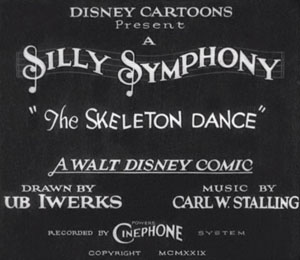 Suspended Animation #330
Suspended Animation #330
Almost every Halloween, the Walt Disney Company seems to showcase one of its earliest black-and-white cartoons, The Skeleton Dance (1929), the very first Silly Symphony.
The working title for the film was The Spook Dance although other suggested titles included Mysterious Melodies and Haunted Harmonies.
While working with Walt Disney on the scores for the first Mickey Mouse cartoons, Carl Stalling, who was basically the Disney Studios’ first music director, had an idea for a new series of cartoons that he suggested in late 1928 with the drawings made to fit the music rather than making the music match Mickey Mouse’s every action.
Initially, Walt thought that Stalling was envisioning something along the lines of the sing-a-long reels that had been done by studios like the Fleischers and had some popularity.
Walt wrote to his brother Roy and Ub Iwerks on September 25, 1928, “Carl’s idea of a skeleton dance for a musical novelty has been growing on me.”
Stalling said, “Ever since I was a kid, I had wanted to see real skeletons dancing and had always enjoyed seeing skelton dancing acts in vaudeville.”
Stalling used a bit of Edvard Grieg’s March of the Dwarfs (1893) but primarily composed an original fox-trot piece so it seemed lively and a little jazzy in keeping with the times.
Stalling recalled, “It wasn’t Saint-Saens’ Danse Macabre, although some writers have said it was. Walt couldn’t get copyright clearance so he asked me to compose something similar, but my music wasn’t similar at all to the Danse Macabre. It was mostly a fox trot, in a minor key.
“For a name or title for the series, I suggested not using the word ‘music’ or ‘musical’, as it sounded too commonplace, but to use the word ‘symphony’ together with a humorous word. At the next gag meeting, I don’t know who suggested it, but Walt asked me: ‘Carl, how would Silly Symphony sound to you?’ I said, Perfect!’”
Animator Ub Iwerks went to the local library for inspiration. He found pictures drawn by the English cartoonist Rowlandson of skeletons dancing. In other books, he found photographs of skeleton dances depicted upon the walls of Etruscan tombs.
It was Iwerks who came up with the idea of the skeletons not rising from their graves to threaten people but just have a playful night of partying with each other. They would socialize, not terrorize. Iwerks experimented with different perspectives as well to provide an experience not previously seen by movie audiences.

Animation under Iwerks began in January 1929 with it taking almost six weeks to finish. The soundtrack was recorded at Pat Powers’ Cinephone studio in New York in February 1929 along with the fifth Mickey Mouse short cartoon The Opry House. According to Roy O. Disney’s records, the total cost for the film was $5,485.40.
On February 10th, Walt wrote to his wife Lillian, “I feel positive the ‘Spook Dance’ will make a real hit when shown. Everyone praises Ubbe’s art work and jokes at his funny name.”
As Walt’s daughter Diane Disney Miller recalled, “Father got a hold of a friend and asked him if he could put him in touch with Fred Miller who managed the Carthay Circle, one of the biggest and most important theaters in town. Father’s friend sent him to a salesman on Film Row.
“Father found the salesman in a pool hall shooting a little Kelly (a game played on a standard pool table with sixteen pool balls). ‘Leave your picture here, Disney,’ the Kelly player said. ‘I’ll look at it. If I like it, I’ll get in touch with you’.
“It sounded like a stall but he actually did look at the film. When he looked he said, ‘I think Fred will like this. I’ll take it over to him myself’’. As a result, Miller showed The Skeleton Dance with a feature picture he was running. It went over big.
“Father clipped the local press notices and mailed them to his distributor Pat Powers with a note: ‘If you can get this to Roxy (the nickname of Broadway showman Samuel L. Rothafel who ran New York’s prestigious Roxy Theater), he’ll go for it the way Miller did. Powers got a print to Roxy and Roxy liked it. He ran it in his huge New York theater.”
It ran at the Carthay Circle theater along with the feature Four Devils starting on June 10th, 1929. It was the first cartoon ever programmed there and the theater would later host the Hollywood premieres of Snow White and the Seven Dwarfs and Fantasia. Walt attended the screening with Iwerks and scratched his head. “Are they laughing at us or with us?” he asked Iwerks.
It ran at the Roxy theater on July 16th, 1929 with Pleasure Crazed. Rothafel wrote, “without exception, one of the cleverest things I have seen and as you know the audience enjoyed every moment of it.”
In early August, Columbia Pictures signed a contract to distribute the Silly Symphonies nationally and made the short available in late August. Its first playdate was again at the Roxy on September 7 shown with Big Time. It was the first time in history that a cartoon had had a second engagement at the theater.
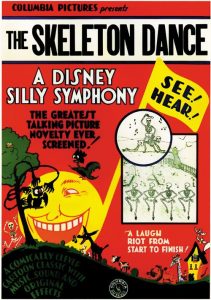 It had an effect on animators as well as the general public. Art Babbitt who had been working at the Paul Terry animation studio told an interviewer that when he saw The Skeleton Dance “I knew that was the place I wanted to work” and quit immediately and left New York to go to Los Angeles.
It had an effect on animators as well as the general public. Art Babbitt who had been working at the Paul Terry animation studio told an interviewer that when he saw The Skeleton Dance “I knew that was the place I wanted to work” and quit immediately and left New York to go to Los Angeles.
Joseph Barbera who would later go on to worldwide fame with his partner William Hanna recalled that he saw the film from the third balcony at the Roxy Theater, “I saw it about seventy miles from the screen, but the impact on me was tremendous nevertheless. I saw these skeletons dancing in a row and in unison, and I asked myself: How do you do that? How do you make that happen?”
Les Clark recalls that Ub animated all of The Skeleton Dance except for the first scene which Clark animated. Year later Clark claimed he had done a scene with a pair of skeletons playing the spines of other skeletons like xylophones. Wilfred Jackson supposedly animated the crowing rooster at the end of the cartoon.
At the time Jackson and Clark were members of the Disney staff but were basically still considered in-betweeners and clean-up artists working with Iwerks. Iwerks was a mentor to the new animators.
The title card for the cartoon says “Drawn by Ub Iwerks,” which is a bit different than the Mickey cartoons which said only “A Walt Disney Comic By Ub Iwerks.”
In an interview done years later, Iwerks stated, “(The Skeleton Dance) was a different type of film from the Mickeys. I did all the animation but I did it rough, in line form. Other guys filled in the rib cages and teeth and eyes and bones.”
Iwerks himself revisited the concept when he directed The Columbia Color Rhapsody entitled Skeleton Frolic (1937). It is very similar to The Skeleton Dance in tone and action but in full, rich color and with much more use of extreme perspective and detail.


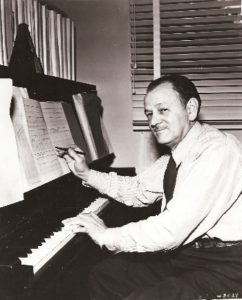
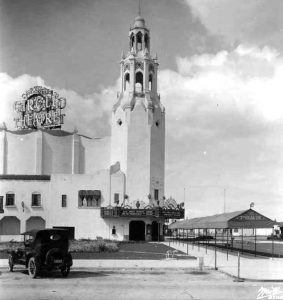
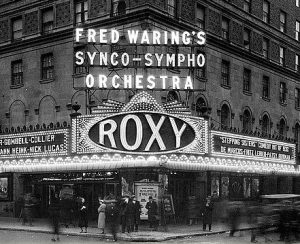
 Jim Korkis is an internationally respected animation historian who in recent years has devoted his attention to the many worlds of Disney. He was a columnist for a variety of animation magazines. With his former writing partner, John Cawley, he authored several animation related books including The Encyclopedia of Cartoon Superstars, How to Create Animation, Cartoon Confidential and Get Animated’s Animation Art Buyer’s Guide. He taught animation classes at the Disney Institute in Florida as well as instructing classes on acting and animation history for Disney Feature Animation: Florida.
Jim Korkis is an internationally respected animation historian who in recent years has devoted his attention to the many worlds of Disney. He was a columnist for a variety of animation magazines. With his former writing partner, John Cawley, he authored several animation related books including The Encyclopedia of Cartoon Superstars, How to Create Animation, Cartoon Confidential and Get Animated’s Animation Art Buyer’s Guide. He taught animation classes at the Disney Institute in Florida as well as instructing classes on acting and animation history for Disney Feature Animation: Florida.




















































Is it Halloween again already? Since my state went back into lockdown, I’ve lost all track of time. Anyway, it’s always a pleasure to watch “The Skeleton Dance”. Every time I do, I notice something different. It just occurred to me that the gag where the skeleton does the Charleston, then a brand new dance craze, must have gotten a huge laugh back in the day.
The success of “The Skeleton Dance” no doubt inspired Disney, Iwerks and Stalling to revisit that theme in the Mickey Mouse cartoon “The Haunted House” later in 1929. Some parts of the earlier cartoon — the dancing skeleton quartet, the bats flying at the viewer, the hairy spider descending on a thread and then crawling offscreen — were reused literally. In contrast to “The Skeleton Dance”, the animation and inking in “The Haunted House” vary in quality from scene to scene. Sometimes the spaces between the ribs are inked in solid black, giving the rib cage the appearance of a flat shield; however, in the brilliantly animated sequence where the skeleton is playing itself like a xylophone, the bones are inked with greater care, and the rib cage has vivid depth and dimension. As in “The Skeleton Dance”, Stalling composed an original foxtrot, also in a minor key.
Two years later, Iwerks and Stalling collaborated on yet another macabre cartoon, “Spooks”, starring Flip the Frog. Flip, like Mickey in “The Haunted House”, seeks shelter from a storm in a spooky old house inhabited by living skeletons. Amusingly, both Flip and Mickey respond to the skeleton’s deep-voiced commands with a compliant “Yes, ma’am!” Both cartoons end with the hero escaping from the house and fleeing over the horizon. “Spooks” has a sequence where Flip dances with a skeleton flapper, but otherwise the cartoon relies more on gags than on music — though a song that would later be used in the Flip cartoon “Funny Face” is played here, as an instrumental, in a minor key.
No wonder “Skeleton Frolic” is such a good cartoon: by then Iwerks had accumulated a fair amount of experience in directing animated skeleton musicals! Too bad there was never a dedicated series of macabre musical cartoons, whether Mysterious Melodies or Haunted Harmonies. The potential was certainly there.
The best part of “Skeleton Frolic” is when the skeleton flutist gives the finger to the skeleton conductor as he plays a sour note that just happens to be in the score. Now there’s a skeleton after my own heart!
Thanks much. l feel most of us love this film. Did not know it was Grieg. https://www.youtube.com/watch?v=ALCpt_ScLl0 , https://www.youtube.com/watch?v=LusZUmeCt_E .
To promote the Disney Silly Symphony Collection on vinyl LPs,Walt Disney Records put a 10″ single of The Skeleton Dance/Three Little Pigs. While also available in the Symphony set,this single with distinct artwork was limited to 2500 during 2016’s Record Store Day.
Let’s not forget the one woman who inked & painted the thousands of cels required to complete “The Skeleton Dance” — Mary Tebb! This legendary artist within Ink & Paint ran Ub’s I&P teams at Iwerks Studio, and after a brief run at other studios, returned to Disney where she supervised color models on Disney shorts & features for many years!
Jumping the gun? Not at all. July is the best time to order Halloween decorations before the prices go up in September, and trick or treat candy will be in the stores any day now.